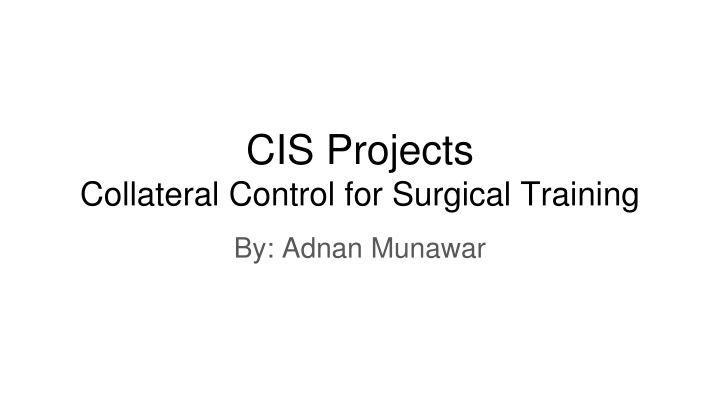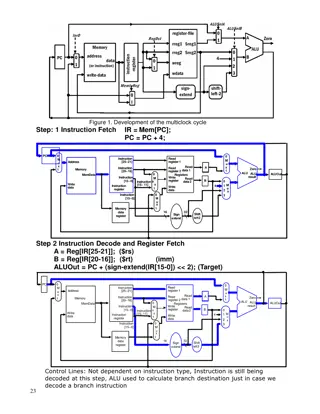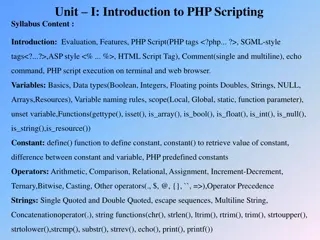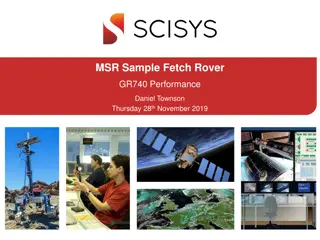
Advanced Surgical Training Control Project
Explore a cutting-edge project focusing on collateral control for surgical training, involving dual dVRK master consoles, impedance controller implementation, and user-study development. Mentored by Adnan Munawar, this project aims to enhance haptic feedback and performance in surgical simulation. Develop key skills in C++, Python, and robotics while contributing to innovative advancements in surgical training technology.
Uploaded on | 1 Views
Download Presentation

Please find below an Image/Link to download the presentation.
The content on the website is provided AS IS for your information and personal use only. It may not be sold, licensed, or shared on other websites without obtaining consent from the author. If you encounter any issues during the download, it is possible that the publisher has removed the file from their server.
You are allowed to download the files provided on this website for personal or commercial use, subject to the condition that they are used lawfully. All files are the property of their respective owners.
The content on the website is provided AS IS for your information and personal use only. It may not be sold, licensed, or shared on other websites without obtaining consent from the author.
E N D
Presentation Transcript
CIS Projects Collateral Control for Surgical Training By: Adnan Munawar
Collateral Control for Surgical Training Background: SISO = Symmetric Input and Symmetric Output In the context of this project, collaborative or collateral control is the control of the same underlying teleoperated robots (or simulated robots/end-effectors) by two or more master users. The control can be subdivided into various modes based on (1) how the feedback forces are supplied to the master users and (2) how the inputs from the masters are supplied to the teleoperated robots. This type of control may prove useful for surgical training tasks and even actual surgical procedures. The AMBF Simulator (developed inhouse) supports multi-device inputs for the manipulation of real-time dynamic simulations with haptic feedback. The goal of this project is to evaluate the performance of collateral control -- based on various metrics -- on the performance of surgical training simulation.
1. Incorporating Dual dVRK Master Consoles What the students will do. 1. 2. Learn the dVRK and AMBF Simulator. Integrate two separate dVRK Master consoles with the AMBF Simulator. Currently, only one console is supported but can be mixed with various other input devices. Group Size: 1-2 student Required Skills: Intermediate C++ and Python Language Familiarity, Robot Kinematics. Mentor: Adnan Munawar (amunawa2@jh.edu)
2. Improving Haptic Feedback of dVRK MTMs What the students will do. 1. 2. Learn the dVRK and AMBF Simulator. Implement an impedance controller for the dVRK MTMs for improved haptic feedback with already estimated dynamic parameters. Update the dynamic models in AMBF (Optional) Publish the results and methods. (Optional) 3. 4. Group Size: 2-3 Students Wang Y, Gondokaryono RA, Munawar A, Fischer GS, A Convex Optimization-based Dynamic Model Identification Package for the da Vinci Research Kit, IEEE Robotics and Automation Letters (RA-L), Vol 4, No 4, Oct 2019 Required Skills: Intermediate C++ and Python Language Familiarity, Robot Kinematics and Dynamics. Mentor: Adnan Munawar (amunawa2@jh.edu)
3. Developing Environments and Conducting User-study What the students will do (split). 1. 2. 3. Learn the dVRK and AMBF Simulator. Develop Simulation Puzzles for evaluation. Perform user-study with a master (preferably a surgeon) and training candidates (could be students). User-study data analysis. Publish the results and methods. (Optional) 4. 5. Group Size: 1-2 Students Required Skills: Linear Algebra, Robot Kinematics and Statistics. Mentor: Adnan Munawar (amunawa2@jh.edu)






















